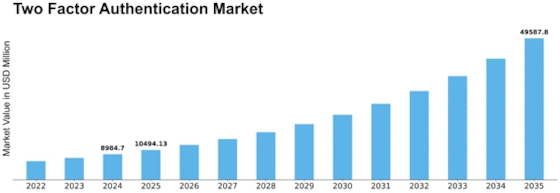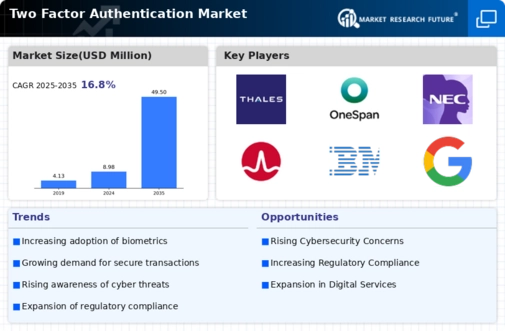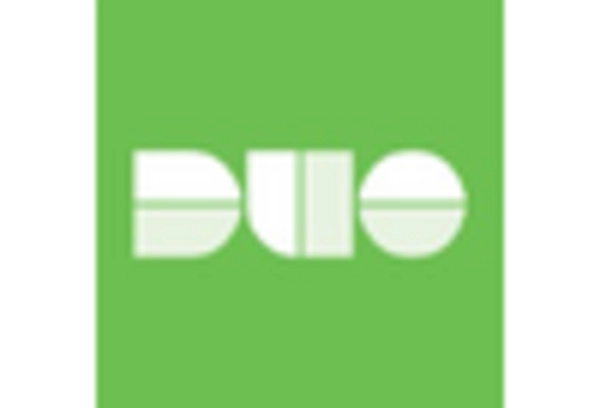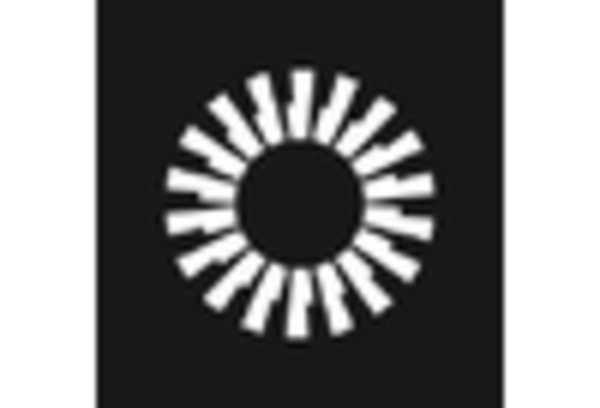Two Factor Authentication Size
Two-Factor Authentication Market Growth Projections and Opportunities
The Two-Factor Authentication (2FA) market is influenced by a multitude of factors that collectively shape its growth and dynamics. A key driver is the escalating concern for cybersecurity in the digital age. As instances of cyber threats, data breaches, and identity theft rise, organizations and individuals alike seek robust security measures, making 2FA a crucial component of secure authentication systems. The heightened awareness of the vulnerabilities associated with traditional password-based authentication fuels the demand for 2FA solutions, which provide an additional layer of security through factors such as biometrics, tokens, or mobile devices.
Regulatory requirements and compliance standards significantly impact the 2FA market. Governments and regulatory bodies worldwide are increasingly mandating the implementation of strong authentication measures to protect sensitive information and ensure data privacy. Compliance with regulations such as GDPR (General Data Protection Regulation) and industry-specific standards drives the adoption of 2FA across various sectors, including finance, healthcare, and e-commerce.
The proliferation of online transactions and the digitalization of services contribute to the expanding scope of the 2FA market. With the rise of e-commerce, online banking, and digital communication, the need for secure user authentication becomes paramount. 2FA provides an additional layer of defense against unauthorized access, protecting user accounts, financial transactions, and sensitive data from cyber threats. The convenience and effectiveness of 2FA in safeguarding digital interactions make it an integral part of the evolving landscape of online services.
The continuous evolution of cyber threats and hacking techniques propels the innovation in 2FA technologies. As cybercriminals become more sophisticated, the 2FA market responds with advanced authentication methods such as facial recognition, fingerprint scanning, and behavioral biometrics. The ongoing development of these technologies ensures that 2FA remains a robust defense against emerging security threats, providing users with adaptive and resilient authentication solutions.
User experience and ease of implementation play a crucial role in influencing the adoption of 2FA. Organizations and service providers recognize the importance of balancing security with user convenience. 2FA solutions that offer seamless integration into existing workflows, user-friendly interfaces, and minimal disruption to user experience gain preference. The user-centric approach contributes to the widespread acceptance of 2FA, as individuals and organizations seek security solutions that do not compromise usability.
The remote work trend and the increasing use of mobile devices impact the 2FA market. With more employees accessing corporate networks and sensitive data from various locations, the need for secure remote authentication grows. Mobile-based 2FA methods, such as authentication apps or SMS verification, align with the mobile-centric work environment, providing a convenient and secure means of user authentication.
The cost-effectiveness of 2FA solutions is a significant market factor. As the awareness of cybersecurity threats grows, businesses of all sizes seek cost-efficient ways to enhance their security posture. 2FA solutions, ranging from hardware tokens to app-based authentication, offer scalable and budget-friendly options for organizations looking to implement strong authentication measures without incurring exorbitant costs.
Competition among 2FA solution providers and strategic partnerships contribute to market dynamics. Established players and emerging companies continually innovate to offer diverse and advanced authentication solutions. Partnerships with technology vendors, cybersecurity firms, and industry stakeholders further drive innovation and expand the reach of 2FA solutions across different sectors.
Interoperability with existing systems and standards is essential for the widespread adoption of 2FA. Organizations often look for solutions that seamlessly integrate with their current authentication infrastructure, minimizing disruptions and compatibility issues. The ability of 2FA solutions to work harmoniously with various platforms and protocols enhances their appeal, making them versatile choices for organizations seeking robust and interoperable security solutions.


















Leave a Comment